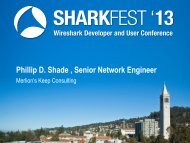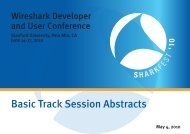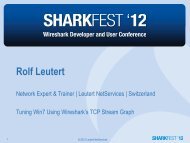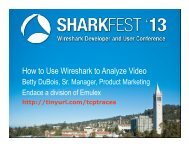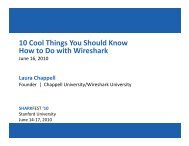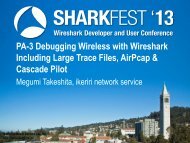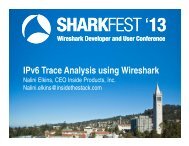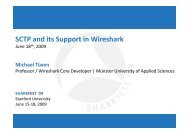A-11: Trace File Anonymization - Sharkfest - Wireshark
A-11: Trace File Anonymization - Sharkfest - Wireshark
A-11: Trace File Anonymization - Sharkfest - Wireshark
You also want an ePaper? Increase the reach of your titles
YUMPU automatically turns print PDFs into web optimized ePapers that Google loves.
A-<strong>11</strong>: <strong>Trace</strong> <strong>File</strong> <strong>Anonymization</strong>Thursday June 16, 20<strong>11</strong>. 1:30pm – 3:00pmJasper BongertzSenior Consultant | Fast Lane Institute for Knowledge TransferSHARKFEST ‘<strong>11</strong>Stanford UniversityJune 13-16, 20<strong>11</strong>SHARKFEST ‘<strong>11</strong> | Stanford University | June 13–16, 20<strong>11</strong>
AgendaSHARKFEST ‘<strong>11</strong> | Stanford University | June 13–16, 20<strong>11</strong>
Motivation for this talk• First of all, I need to anonymize traces myself– Training material for student– <strong>Sharkfest</strong> talks („Have <strong>Wireshark</strong> will travel“)• Question asked on ask.wireshark.org– http://ask.wireshark.org/questions/844/utility-toanonymize-capture-files• Apologies– I focussed on just a few tools. If you wrote oneand it isn‘t included: sorry! Mail me. Maybe I doan updated talk sometime, somewhere SHARKFEST ‘<strong>11</strong> | Stanford University | June 13–16, 20<strong>11</strong>
Why trace file anonymization?• Removing sensitive information from tracefiles• Personal privacy– User IDs, passwords, IP addresses,...• Confidential corporate information– Network topology– Potential choke points (DoS/DDoS)– Device & Software version information (CDP, LLDP)– Vulnerable protocolsSHARKFEST ‘<strong>11</strong> | Stanford University | June 13–16, 20<strong>11</strong>
Ways to anonymize• Even <strong>Wireshark</strong> can do it!– Capture data with „Limit each packet to...“– Example: SMTP traffic patterns• Can also be done after captureusing „editcap –s “• Using capture filters to excludesensitive packets– filter on VLAN tags, Ethernet or IP addresses,TCP/UDP portsSHARKFEST ‘<strong>11</strong> | Stanford University | June 13–16, 20<strong>11</strong>
Ways to anonymize• On-the-fly anonymization– Anonymize tracefiles while they‘re captured– Modification is done between capturing thepackets and writing them to disk• Challenges– <strong>Anonymization</strong> process must be fast enough toavoid drops– Original data can‘t be examined as it is neverwritten to diskSHARKFEST ‘<strong>11</strong> | Stanford University | June 13–16, 20<strong>11</strong>
<strong>Trace</strong> file modification• Replace sensitive information with harmlessinformation• „Seek and destroy“– Look for parts that need to be replaced andreplace them– Might overlook details in „unexpected places“– Problem with unknown protocolsSHARKFEST ‘<strong>11</strong> | Stanford University | June 13–16, 20<strong>11</strong>
<strong>Trace</strong> file modification• „Defensive Transformation“– Copies and anonymizes known protocol headervalues– Removes or wipes all unknown parts– No chance of keeping sensitive information bymistake• Core problem: layer 5-7 content– No well known header formats– Unknown UDP/TCP payload data format (ifformatted at all)SHARKFEST ‘<strong>11</strong> | Stanford University | June 13–16, 20<strong>11</strong>
Layers 1-4 – interesting data• Ethernet• IP– MAC vendor code (products used in the company)– Source, Destination address (network ranges)– Time To Live (topology)• TCP– Source, Destination Port (Protocols in use)– Sequence Numbers (predictable?)• UDP– Source, Destination Port (Protocols in use)SHARKFEST ‘<strong>11</strong> | Stanford University | June 13–16, 20<strong>11</strong>
Layers 1-4 – interesting data• ICMP– Destination Unreachable– Communication Filtered (ACL/Firewall)– TTL exceeded (Topology)– Redirect (Topology)– Quote of problem packetSHARKFEST ‘<strong>11</strong> | Stanford University | June 13–16, 20<strong>11</strong>
<strong>Anonymization</strong> Challenges• Keeping replacements consistent– Not only within one trace file, but across multipletrace files, too– MAC and IP addresses, TCP and UDP Ports• Address range challenges– Replace IPs from the same subnet to end up in thesame anonymized subnet– Class A/B/C easy compared to stuff like /29– Avoid randomizing broadcast addresses to unicastaddressesSHARKFEST ‘<strong>11</strong> | Stanford University | June 13–16, 20<strong>11</strong>
Address Replacement Strategies• By specifying command line parameters• Random numbers– Brute force method, hard to read a traceafterwards• Using tables to keep replacements persistent– Might need lots of memory– <strong>Trace</strong>s need to be processed sequentially• Hashing original bytes to get a replacementSHARKFEST ‘<strong>11</strong> | Stanford University | June 13–16, 20<strong>11</strong>
SHARKFEST ‘<strong>11</strong> | Stanford University | June 13–16, 20<strong>11</strong>
Tools not considered• Some tools were not considered because wefocus on reusability with <strong>Wireshark</strong>– We‘re here for packet analysis, so we like pcaps– Most users use Linux or Windows as a platform• Sanitize, CryptoPAn– Output is ASCII, not a capture file• tcpdpriv– Didn‘t work on Linux or Windows (probably myown fault though )SHARKFEST ‘<strong>11</strong> | Stanford University | June 13–16, 20<strong>11</strong>
The hard way• Editing tracefiles manually, byte by byte– „when I was your age we did it like this:“echo „Ôò¡ ÿÿ „ > mycap.pcap• Editing tracefiles using hex editors– Mostly for fixing checksum errors caused by tcpchecksum offloading– Very slow– Easy to miss critical data when doing tracefilesanitationSHARKFEST ‘<strong>11</strong> | Stanford University | June 13–16, 20<strong>11</strong>
<strong>Anonymization</strong> Tools• Command line parameter tools– Editcap (just for truncating files)– Tcprewrite– Bittwiste• „Fully automated“ tools– pktanonSHARKFEST ‘<strong>11</strong> | Stanford University | June 13–16, 20<strong>11</strong>
<strong>Anonymization</strong> Tools - tcprewrite• Command line tool• Reads input file, replaces content specified byparameters, writes output file• Can add/remove VLAN tags• Can skip replacing broadcast addresses• Replaces IP addresses consistently by usingseeds– Also works with IPv6 • Subnet IP replacing with --pnat optionSHARKFEST ‘<strong>11</strong> | Stanford University | June 13–16, 20<strong>11</strong>
<strong>Anonymization</strong> Tools - tcprewrite• Calculates correct checksums for editedframes– Information about existing bad checksums insource file is lost• Allows recalculating bad checksums onpurpose– Used to fix „checksum offloading“ problems– Important if trace has to be replayedSHARKFEST ‘<strong>11</strong> | Stanford University | June 13–16, 20<strong>11</strong>
<strong>Anonymization</strong> Tools - tcprewrite• --fixlen option to handle sliced frames• Mostly needed for replay, not for packetanalysis• Three options:– --fixlen=trunc reduces the frame length to thenumber of captured bytes– --fixlen=pad adds 0x00 bytes to fill frame to matchthe original frame length– --fixlen=del deletes frames with original lengthbigger than captured sizeSHARKFEST ‘<strong>11</strong> | Stanford University | June 13–16, 20<strong>11</strong>
<strong>Anonymization</strong> Tools - bittwiste• Editor coming with bittwist (packet replay)• Does not like some not so uncommon things– VLAN tags, IPv6 packets• Lots of options similar to editcap– Saving by timeframe, packet range• Allows deleting bytes from offsets• -L option to truncate packets after layer 2-4– Unlike editcap, headers with options are not aproblemSHARKFEST ‘<strong>11</strong> | Stanford University | June 13–16, 20<strong>11</strong>
<strong>Anonymization</strong> Tools - bittwiste• -C option to skip correcting checksums– crc of edited packets is always kept from theoriginal trace -> does not match anymore– Without option set, crc is always recalculated,even for bad original frames• -T option to modify headers– Need to specify layer: eth,arp,ip,tcp,udp,icmp– Must be last parameter– Only one –T option per runSHARKFEST ‘<strong>11</strong> | Stanford University | June 13–16, 20<strong>11</strong>
<strong>Anonymization</strong> Tools - bittwiste• IP address replacement options– Set source or destination to a specific IP– Replace existing source/destination IP withspecific source/destination IP– No random/automatic IP replacingSHARKFEST ‘<strong>11</strong> | Stanford University | June 13–16, 20<strong>11</strong>
<strong>Anonymization</strong> Tools - pktanon• Uses XML files to specify– source/destination filename– anonymization options• VLAN tags are not recognized– <strong>Trace</strong> is anonymized but crippled after Ethernetheaders• Defensive transformation– Only transfers and optionally anonymizes parts itunderstands• Can handle encapsulations like IP-in-ICMPSHARKFEST ‘<strong>11</strong> | Stanford University | June 13–16, 20<strong>11</strong>
<strong>Anonymization</strong> Tools - pktanon• Checksum recalculation option– Can keep bad original checksums with„SetBadChecksumsToBad“ option• Anonymizing IP addresses– Achieving constistant IP address replacementusing hashs of single octets– Keeps IPs from the same subnet in the samereplacement subnet– Also works with IPv6 addressesSHARKFEST ‘<strong>11</strong> | Stanford University | June 13–16, 20<strong>11</strong>
• Can handle layer 5-7 payloads– Replace with 0x00 or truncate payload• Is able to anonymize tracefiles „on the fly“– tcpdump -i eth0 -s 0 -w - | pktanon ./settings.xmlSHARKFEST ‘<strong>11</strong> | Stanford University | June 13–16, 20<strong>11</strong>
Thinking out of the box• Problem: sometimes, traces contain knownprotocols on weird port numbers• Usually, we do „Decode As“in <strong>Wireshark</strong>• Setting is volatile betweenopening traces• Trick: use tcprewrite or bittwiste to rewriteport numbers to a well known port– But keep the original as well, just to be sure!SHARKFEST ‘<strong>11</strong> | Stanford University | June 13–16, 20<strong>11</strong>
The anontracer VM• VMware workstation machine• tshark, tcpdump, editcap, tcprewrite, bittwisteand pktanon already installed and good to go• Automatic mode for pktanon:– Drop a file into low/med/high directory– Runs anonymization according to .settings.xml– Anonymized file is put into same directory– Accessable via WebDav, ftp, SMB, sshSHARKFEST ‘<strong>11</strong> | Stanford University | June 13–16, 20<strong>11</strong>
Thanks• I have to thank a couple of guys:• Oliver Ripka, for creating the anontracer VMfor me• Eduard Blenkers, Christian Landström andSilvia Hagen, for providing fun traces• The creators of tcprewrite, bittwiste andpktanon– Great job guys, I learned a lot while playingaround with thoseSHARKFEST ‘<strong>11</strong> | Stanford University | June 13–16, 20<strong>11</strong>
Questions?SHARKFEST ‘<strong>11</strong> | Stanford University | June 13–16, 20<strong>11</strong>




